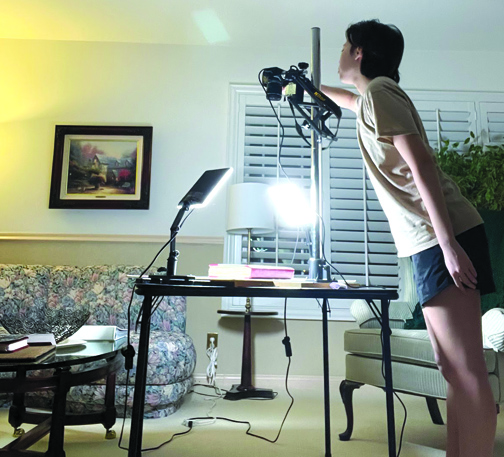
By Lori BODNAR, intern
Annie Brundige, a Girl Scout in Troop 1761, was recently awarded the Gold Award for her project that reflected on the organization over the decades.
Brundige has been a Girl Scout for 13 years, since kindergarten. Through the Girl Scout organization, she earned her Bronze Award, Silver Award and now her Gold Award, in addition to numerous other Scout badges. The Gold Award is the highest individual award in Girl Scouts, comparable to the Boy Scout Eagle Award. Only 6% of eligible Girl Scouts across the nation earn the Gold Award. A Gold Award project must be meaningful, sustainable, have a community impact, be approved by the Girl Scout council, and requires at least 80 hours of volunteer service.
Brundige spent over 150 volunteer hours on her Gold Award project, in which she digitized and organized stories of Girl Scouts from the 1930s, 1940s and 1950s using scrapbooks stored in the Glendale Girl Scout Program Center.
“My mom helped me come up with my Gold Award project to organize and digitize these scrapbooks,” said Brundige. “This is a need in the community because these scrapbooks were not properly handled and were deteriorating, along with the information and photos contained within them. My project creates awareness for the good that Girl Scouts have done in this community for decades.”
The Glendale Girl Scout Program Center has been used continuously since the 1930s to host badge earning days, celebrations or Troop meetings. Digitally archiving the memorabilia and placing the information on the CSUN library site on the Internet is a service to educate and create awareness for the service performed by Girl Scouts in the Crescenta Valley. Girl Scouts has an official memorabilia branch at the national level, but not at a more local level.
“We researched ways to digitize these scrapbooks but didn’t know where to start,” Brundige said. “My mom and I found that Christina Rice was the head archivist at the Los Angeles downtown library who happened to be a Girl Scout parent, so Christina became my project advisor. She helped direct me with my project. I organized the collection by series of locations, then by date, in my kitchen. Christina introduced what a finding aid is and gave examples. She referred me to USC, but then we heard about the ‘L.A. as Subject Digital Residency Program.’ After being approved to start my Gold Award, we applied to the program and happily got accepted. Crystal Johnson was assigned to us.”
Sometimes challenges arise during a Gold Award process, and Girl Scouts needed to adapt to overcome these obstacles.
“We finished the finding aid, but lockdown happened, so we had to start with metadata first instead of digitization,” Brundige said.
Metadata, or information that describes other data, is important for the reader to understand both context and specific words used as descriptors.
“Metadata and digitization are both crucial to the process of archiving,” Brundige continued. “We had to do this over Zoom for the remainder of our time, which created problems such as Internet lagging, backorder on lights, learning online, and not being able to have a hands-on approach. However, Crystal’s personalized slideshows helped me learn metadata.”
After learning metadata, Brundige translated that knowledge into physical form.
“At first, I felt like I had a giant hill stacked with books that I had to overcome,” Brundige recalled. “It was daunting but, after doing a couple, it wasn’t so bad. Doing little by little really helped my confidence. I started enjoying metadata after properly learning how to use a spreadsheet.”
She also needed to gather equipment for the digitization process including a copy stand from CSUN, her Nikon D3500 with a wire transfer, DIY weights, white poster board, lights, PC computer and an ESPOn Perfection V90 scanner.
“After a couple of trial and errors, I learned how to digitize the scrapbooks without glare and dust-spots,” she said. “I’ve learned a lot more about digitization of archival documents and photos.”
Her Girl Scout Gold Award project will have a lasting and positive impact on the community.
“The digitization and metadata from this project sets the groundwork on properly storing memorabilia, creates a higher standard and informs people. This will also create a more cohesive way for the Heritage Committee of Upland to access and store Girl Scout information,” she said.
Brundige presented her work to members from CSUN and USC at an LA as Subject event. Her digitized information “Hometown Heroes: Girl Scouts of the Crescenta Valley” is accessible through the California State University Northridge Digital Collection weblink https://digital-library.csun.edu/girl-scouts.
Brundige’s mother, Patti, is the leader of Girl Scout Troop 1761. She also earned her Gold Award when in Girl Scouts, and she instilled the importance of community service to her family; in addition to Annie, her older sister also earned her Gold Award.
“Ever since I was young, I remember volunteering with my family and how important it is to give back to the community,” Brundige said. “My family has been longtime members and volunteers for the Girl Scouts. Some of my favorite experiences are going to camp or meeting other Girl Scouts. My mom has volunteered much of her time to Girl Scouts, and so I would be brought along to help all the time. I always did the things that no one else wanted to do, because that’s part of doing good and working hard.”
